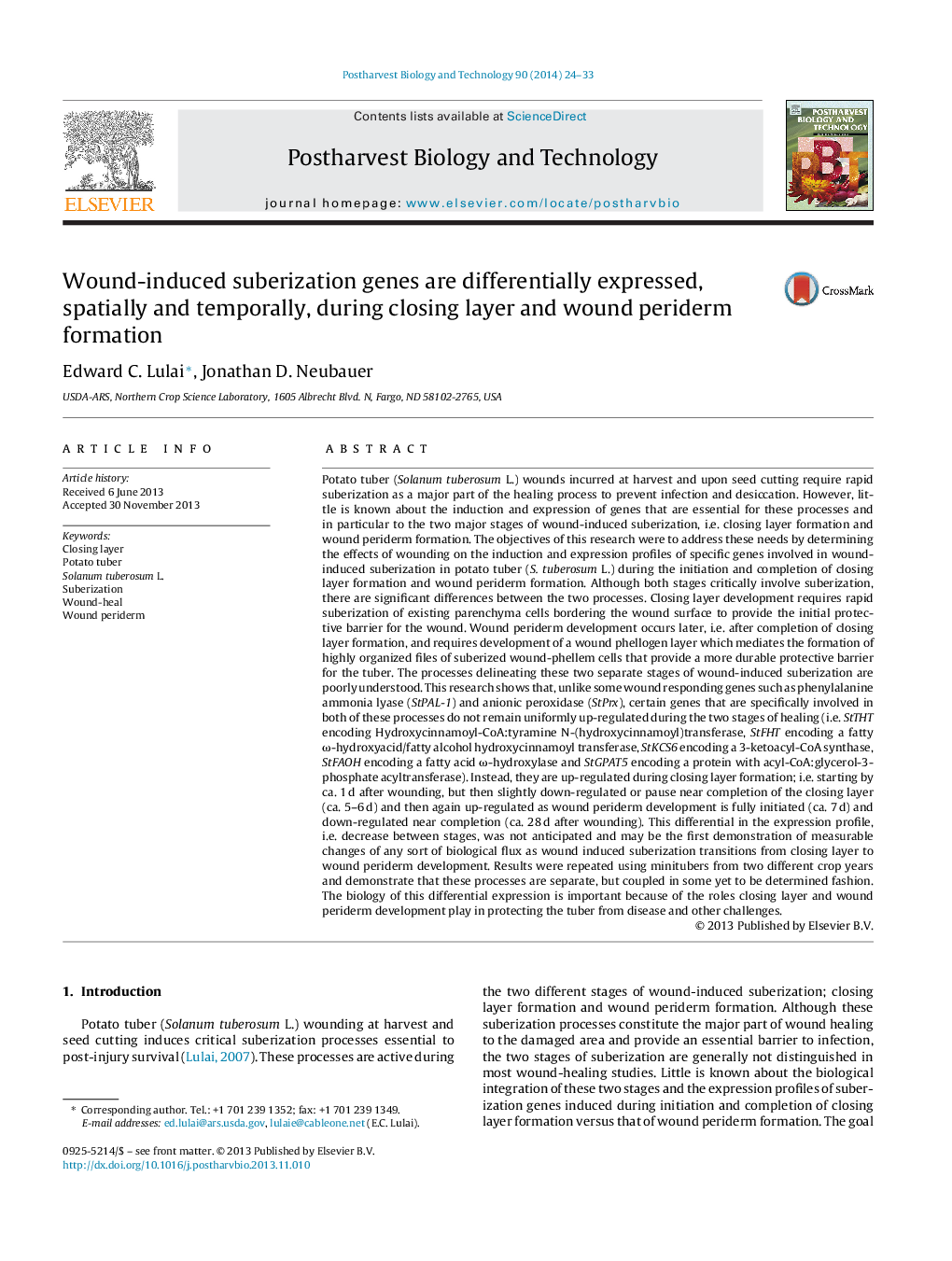| کد مقاله | کد نشریه | سال انتشار | مقاله انگلیسی | نسخه تمام متن |
|---|---|---|---|---|
| 4518138 | 1625004 | 2014 | 10 صفحه PDF | دانلود رایگان |
عنوان انگلیسی مقاله ISI
Wound-induced suberization genes are differentially expressed, spatially and temporally, during closing layer and wound periderm formation
ترجمه فارسی عنوان
ژن های سوپریزاسیون ناشی از زخم به طور متقابل بیان می شوند، فضایی و زمانی، در طول بسته شدن لایه و تشکیل پریدرم زخم
دانلود مقاله + سفارش ترجمه
دانلود مقاله ISI انگلیسی
رایگان برای ایرانیان
موضوعات مرتبط
علوم زیستی و بیوفناوری
علوم کشاورزی و بیولوژیک
علوم زراعت و اصلاح نباتات
چکیده انگلیسی
Potato tuber (Solanum tuberosum L.) wounds incurred at harvest and upon seed cutting require rapid suberization as a major part of the healing process to prevent infection and desiccation. However, little is known about the induction and expression of genes that are essential for these processes and in particular to the two major stages of wound-induced suberization, i.e. closing layer formation and wound periderm formation. The objectives of this research were to address these needs by determining the effects of wounding on the induction and expression profiles of specific genes involved in wound-induced suberization in potato tuber (S. tuberosum L.) during the initiation and completion of closing layer formation and wound periderm formation. Although both stages critically involve suberization, there are significant differences between the two processes. Closing layer development requires rapid suberization of existing parenchyma cells bordering the wound surface to provide the initial protective barrier for the wound. Wound periderm development occurs later, i.e. after completion of closing layer formation, and requires development of a wound phellogen layer which mediates the formation of highly organized files of suberized wound-phellem cells that provide a more durable protective barrier for the tuber. The processes delineating these two separate stages of wound-induced suberization are poorly understood. This research shows that, unlike some wound responding genes such as phenylalanine ammonia lyase (StPAL-1) and anionic peroxidase (StPrx), certain genes that are specifically involved in both of these processes do not remain uniformly up-regulated during the two stages of healing (i.e. StTHT encoding Hydroxycinnamoyl-CoA:tyramine N-(hydroxycinnamoyl)transferase, StFHT encoding a fatty Ï-hydroxyacid/fatty alcohol hydroxycinnamoyl transferase, StKCS6 encoding a 3-ketoacyl-CoA synthase, StFAOH encoding a fatty acid Ï-hydroxylase and StGPAT5 encoding a protein with acyl-CoA:glycerol-3-phosphate acyltransferase). Instead, they are up-regulated during closing layer formation; i.e. starting by ca. 1Â d after wounding, but then slightly down-regulated or pause near completion of the closing layer (ca. 5-6Â d) and then again up-regulated as wound periderm development is fully initiated (ca. 7Â d) and down-regulated near completion (ca. 28Â d after wounding). This differential in the expression profile, i.e. decrease between stages, was not anticipated and may be the first demonstration of measurable changes of any sort of biological flux as wound induced suberization transitions from closing layer to wound periderm development. Results were repeated using minitubers from two different crop years and demonstrate that these processes are separate, but coupled in some yet to be determined fashion. The biology of this differential expression is important because of the roles closing layer and wound periderm development play in protecting the tuber from disease and other challenges.
ناشر
Database: Elsevier - ScienceDirect (ساینس دایرکت)
Journal: Postharvest Biology and Technology - Volume 90, April 2014, Pages 24-33
Journal: Postharvest Biology and Technology - Volume 90, April 2014, Pages 24-33
نویسندگان
Edward C. Lulai, Jonathan D. Neubauer,
